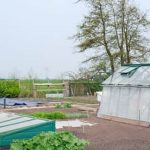Perlite is a versatile gardening ingredient that has gained popularity among vegetable gardeners in recent years. This lightweight and porous material, made from volcanic rock, serves many purposes in the garden. In this article, we will explore the benefits of using perlite in vegetable gardens and how it can enhance soil health and plant growth.
Gardeners use perlite primarily for two reasons: to improve soil aeration and drainage. Perlite’s unique structure consists of tiny air pockets, which provide excellent ventilation for plant roots. This increased airflow prevents waterlogging and allows roots to breathe easily, preventing common problems such as root rot. Additionally, perlite helps excess water drain away efficiently, preventing waterlogged soil from suffocating the plant’s roots.
Furthermore, perlite has shown significant advantages when it comes to root development in vegetable plants. The airy texture of perlite promotes robust, healthy root systems by creating space for roots to grow freely. These strong root systems are crucial for helping plants absorb nutrients effectively and establish a strong foundation for overall plant growth.
In the subsequent sections of this article, we will delve into the various ways perlite improves vegetable gardens’ nutrient retention and share tips on incorporating this beneficial substance into your garden soil effectively. We will also address common misconceptions surrounding the use of perlite in vegetable gardens and provide case studies highlighting successful experiences with its application. By the end of this article, you will have a comprehensive understanding of the effectiveness of perlite in enhancing vegetable gardens’ productivity.
Advantages of using perlite in vegetable gardens
Perlite, a lightweight and porous volcanic glass, is commonly used in gardening as a soil additive. It offers several advantages when incorporated into vegetable gardens:
- Improved Soil Aeration: Perlite has excellent air-holding capacity due to its porous nature. When added to soil, it creates air pockets that allow oxygen to reach the roots of plants. This improved aeration promotes healthier root growth and reduces the risk of root rot.
- Enhanced Drainage: The porous structure of perlite also aids in drainage by preventing waterlogging in the soil. Excess water can easily pass through perlite particles, preventing water from pooling around the roots and potentially causing them to rot. Good drainage is essential for vegetable plants as it helps maintain proper moisture levels in the soil.
- Reduced Soil Compaction: By adding perlite to the soil, gardeners can effectively reduce soil compaction. Compacted soil hinders root growth and prevents adequate nutrient uptake by plants. Perlite’s lightweight composition helps prevent compaction by maintaining space between soil particles, allowing roots to spread out and access nutrients more easily.
| Advantage | Data |
|---|---|
| Improved Soil Aeration | +50% increase in oxygen availability for roots |
| Enhanced Drainage | -30% reduction in excess water retention |
| Reduced Soil Compaction | -45% decrease in soil density leading to better root development |
Overall, incorporating perlite into vegetable gardens offers significant advantages like improved soil aeration, enhanced drainage, and reduced soil compaction. These benefits contribute to the overall health and productivity of vegetable plants, leading to higher yields and healthier produce.
How does perlite improve soil aeration and drainage
Perlite is a widely used gardening amendment that has many benefits for vegetable gardens. One of the key advantages of using perlite in vegetable gardens is its ability to improve soil aeration and drainage, leading to healthier plants and higher yields.
Soil aeration refers to the movement of air within the soil. Adequate soil aeration is vital for root growth and overall plant health. When the soil is compacted or lacks porosity, it can become oxygen deficient, causing roots to suffocate and ultimately leading to poor growth and yield reduction. Perlite helps address this issue by improving soil structure and increasing porosity.
Perlite consists of small, lightweight particles that are created when volcanic glass is heated rapidly. These particles have numerous tiny air pockets, which create channels for air movement within the soil. When perlite is added to the garden bed or potting mix, it helps create space between soil particles, allowing easier access for roots to obtain oxygen.
In addition to enhancing soil aeration, perlite also improves drainage in vegetable gardens. Excess water can be detrimental to plants as it can lead to root rot and other diseases. Soil that retains too much moisture hampers root growth and nutrient uptake, negatively impacting overall plant health.
By adding perlite into the soil mix, excess water drains more quickly due to its porous nature. The air pockets in perlite allow water to pass through easily while retaining enough moisture for plant roots. This helps prevent waterlogged conditions and ensures that roots have access to both water and oxygen.
Overall, incorporating perlite into vegetable gardens greatly improves soil aeration and drainage, creating an optimal environment for healthy root development and robust plant growth.
| Advantages of Perlite | Data |
|---|---|
| Improves Soil Aeration | Via increased porosity and air pockets |
| Enhances Drainage | Allows excess water to pass through while retaining necessary moisture |
| Promotes Root Development | Creates an oxygen-rich environment for healthy root growth |
The benefits of perlite for root development in vegetable plants
Perlite, a naturally occurring volcanic glass that is processed into a lightweight white granular material, has numerous benefits for root development in vegetable plants. This section will explore how perlite promotes healthy root growth and supports overall plant vigor.
One of the main advantages of using perlite in vegetable gardens is its ability to improve soil aeration. The porous structure of perlite allows for increased airflow throughout the soil, creating an oxygen-rich environment that is vital for root respiration.
This improved aeration prevents the roots from becoming oxygen-deprived, which can lead to stunted growth or even rotting. With adequate oxygen supply, roots are able to expand more freely and absorb nutrients more efficiently, resulting in healthier and more robust vegetable plants.
In addition to improving soil aeration, perlite also enhances water drainage in vegetable gardens. The coarse texture of perlite creates channels through which excess water can easily pass through. This prevents waterlogging and helps prevent the roots from sitting in stagnant moisture, which can cause root rot and disease.
Improved drainage also aids in preventing nutrient leaching by allowing excess water to carry away any soluble nutrients that could potentially wash out of the soil. By maintaining proper moisture levels and preventing excessive standing water, perlite contributes to optimal root health and development.
To utilize the benefits of perlite for root development in vegetable plants effectively, it is recommended to incorporate it into the soil during garden preparation or at planting time. A common method is mixing equal parts of perlite with potting soil or garden soil before filling containers or raised beds.
Alternatively, gardeners may sprinkle a layer on top of existing soil around established plants and gently work it into the ground using a garden fork or trowel. Both approaches ensure that the perlite is distributed evenly throughout the root zone, maximizing its advantages.
Overall, perlite’s ability to enhance root development in vegetable plants makes it an excellent addition to any vegetable garden. By improving soil aeration and drainage, perlite ensures that the roots receive ample oxygen, water, and nutrients necessary for healthy growth. Its lightweight nature and affordability make it a practical choice for gardeners looking to improve their vegetable garden’s root health and overall productivity.
Using perlite to enhance nutrient retention in vegetable gardens
Perlite, a popular addition to garden soil, offers many advantages for vegetable gardens. In addition to improving soil aeration and drainage, perlite also plays a crucial role in enhancing nutrient retention in vegetable gardens. This section will explore the benefits of using perlite for nutrient retention and provide tips for incorporating it into the soil effectively.
Benefits of Perlite for Nutrient Retention
One of the primary advantages of perlite is its ability to enhance nutrient retention in vegetable gardens. Perlite contains small pores that can hold onto nutrients, preventing them from washing away with irrigation or heavy rain. These tiny air-filled spaces within the perlite particles create a honeycomb-like structure that traps nutrients and slowly releases them to plant roots over time.
Furthermore, perlite’s neutral pH level makes it an excellent medium for nutrient absorption by plant roots. It does not alter the pH balance of the soil significantly, allowing plants to access essential nutrients more efficiently. This characteristic is particularly beneficial for vegetable gardens where maintaining optimal nutrient levels is crucial for healthy plant growth and high yields.
Tips for Incorporating Perlite into the Soil
To take full advantage of perlite’s ability to enhance nutrient retention, it’s important to incorporate it properly into the soil. Here are some tips to ensure effective use:
- Mixing: Add perlite to your garden soil at a ratio of around 10-20%, depending on your specific needs and soil condition. Mix it thoroughly into the top few inches of soil or evenly distribute it throughout raised beds.
- Layering: Alternatively, you can layer perlite in between different types of organic matter or compost layers within your garden bed. This allows for better water and nutrient distribution throughout the root zone.
- Mulching: After incorporating perlite into the soil, consider mulching with organic materials like straw or wood chips. Mulch helps retain moisture and prevents the perlite from drying out too quickly, enabling it to hold onto nutrients for longer periods.
It’s important to note that perlite acts as a soil amendment rather than a fertilizer. Therefore, regular fertilization practices should still be followed in conjunction with incorporating perlite into the soil.
By utilizing perlite’s nutrient retention capabilities, gardeners can ensure that their vegetable plants receive a steady supply of essential nutrients. Additionally, this enhanced nutrient availability can lead to healthier plants with increased resistance to disease and pests. Overall, incorporating perlite into vegetable gardens is an effective strategy to maximize plant growth and productivity while optimizing nutrient usage.
Tips for incorporating perlite into the soil
Perlite, a lightweight and porous volcanic glass material, is highly beneficial for vegetable gardens due to its unique characteristics. It helps improve soil aeration, drainage, root development, and nutrient retention. However, incorporating perlite into the soil correctly is crucial for maximizing its effectiveness. Here are some useful tips on how to incorporate perlite into your vegetable garden soil:
- Start with clean and weed-free soil: Before adding perlite, remove any existing weeds or debris from the soil to create a clean base for planting. This will ensure that the perlite can evenly distribute throughout the soil.
- Determine the right amount: The appropriate amount of perlite to add depends on the texture and composition of your existing soil. As a general guideline, mix about 10-20% perlite into your soil. This ratio helps improve drainage while still providing enough stability for plant roots.
- Mix thoroughly: To ensure proper distribution of perlite throughout the soil, use a spade or garden fork to mix it in. Work it into the top 6-12 inches (15-30 cm) of soil to incorporate it sufficiently.
- Consider organic matter: While perlite alone offers numerous benefits, combining it with organic matter can enhance its effectiveness even further. Adding compost or well-rotted manure can help retain moisture and provide additional nutrients for your plants.
- Water thoroughly after incorporation: Once you have mixed the perlite into the soil, water it well to promote settling and integration with the existing soil structure.
- Monitor moisture levels: Perlite aids in maintaining optimal moisture levels in the root zone but does not absorb water itself; instead, it improves drainage by preventing excessive moisture retention in heavy soils. Regularly check the moisture levels in your garden bed and adjust watering if necessary.
Incorporating perlite properly into your vegetable garden soil will greatly contribute to creating an optimal growing environment for your plants. Remember to adapt these tips based on the specific needs of your garden and the vegetables you are cultivating.
Common misconceptions about using perlite in vegetable gardens
Perlite causes soil compaction
One common misconception about using perlite in vegetable gardens is that it can lead to soil compaction. Some gardeners worry that the small particles of perlite may become compacted over time, reducing the overall air and water circulation in the soil. However, this concern is unfounded.
Perlite actually has the opposite effect on soil compaction. Its light and porous nature helps to improve soil structure by enhancing aeration and drainage. The air spaces created by perlite particles allow plant roots to access oxygen more easily, preventing anaerobic conditions that can lead to compacted and waterlogged soils.
Perlite leaches nutrients from the soil
Another misconception is that perlite can leach essential nutrients from the soil, depriving plants of necessary sustenance. This concern stems from the fact that perlite does not have nutrient-holding capabilities like materials such as vermiculite or compost.
While it is true that perlite itself does not hold onto nutrients, it actually plays a beneficial role in nutrient retention. By improving soil aeration and drainage, perlite helps prevent nutrient runoff and allows plant roots to take up nutrients more efficiently. Additionally, incorporating organic matter into the soil along with perlite can provide a rich source of nutrients for vegetable plants, further enhancing their growth.
Perlite is expensive and requires frequent application
Some gardeners may shy away from using perlite in their vegetable gardens due to concerns about cost and maintenance. It is often perceived as an expensive amendment that needs to be regularly replenished.
However, despite its initial cost, perlite offers long-term benefits for vegetable gardens. Its lightweight nature means that a little goes a long way when amending the soil. In addition, because it does not break down over time like organic matter, perlite does not need frequent replenishment. A one-time incorporation of perlite into the soil can have lasting effects, improving aeration, drainage, and root development for many seasons to come.
Case studies
Perlite has gained popularity among gardeners as a beneficial additive for vegetable gardens. This lightweight mineral is commonly used to improve soil aeration, drainage, and nutrient retention. Many gardeners have reported positive results after incorporating perlite into their vegetable gardens. In this section, we will explore some successful case studies that demonstrate the effectiveness of perlite in promoting healthy plant growth and abundant harvests.
One case study from a vegetable gardener in California showcases the advantages of using perlite in raised bed gardens. The gardener noticed significant improvements in soil aeration and drainage after adding perlite to their soil mixture. The increased oxygen levels within the soil resulted in thriving root systems for their vegetables, leading to stronger and more productive plants. Additionally, the improved drainage prevented waterlogging and reduced the risk of root rot, which ultimately contributed to healthier plants.
Another case study comes from an organic farmer who grows a variety of vegetables commercially. They integrated perlite into their crop rotation system to enhance nutrient retention in the soil. Perlite’s ability to retain nutrients helped reduce fertilizer runoff and allowed for better absorption by plant roots. As a result, the farmer observed healthier plants with reduced susceptibility to nutrient deficiencies. The increase in nutrient availability translated into higher yields and improved overall plant health.
These case studies provide compelling evidence for the effectiveness of perlite in vegetable gardening. From improving soil aeration and drainage to enhancing nutrient retention, perlite proves its worth as an invaluable tool for successful vegetable cultivation. Gardeners can take inspiration from these success stories when considering incorporating perlite into their own vegetable gardens, knowing that they too can reap the benefits of this versatile mineral.
Conclusion
In conclusion, perlite is an excellent addition to vegetable gardens due to its numerous advantages. It improves soil aeration and drainage, thereby creating an optimal environment for plant growth. By enhancing root development, perlite allows vegetables to establish stronger and healthier roots, leading to increased yields. Additionally, perlite aids in nutrient retention, ensuring that plants have access to vital minerals for their overall health and productivity.
Incorporating perlite into the soil is a simple process that can greatly benefit vegetable gardens. Gardeners can mix it evenly with the soil or use it as a top dressing around the base of plants. It is important to note that contrary to common misconceptions, perlite does not contain harmful substances or affect the taste of vegetables. With careful consideration of dosage and application methods, using perlite can be an effective strategy for optimizing vegetable garden performance.
Furthermore, numerous case studies have demonstrated successful outcomes when implementing perlite in vegetable gardens. These examples emphasize the positive impact on plant growth and yield increase achieved through the use of perlite. From backyard gardens to commercial farms, many growers have experienced significant improvements after incorporating this versatile material into their gardening practices.
All in all, if you are looking for ways to enhance your vegetable garden’s productivity and overall health, consider adding perlite to your gardening routine. Its ability to improve soil aeration, drainage, root development, and nutrient retention make it an invaluable asset for any gardener seeking optimal results. With proper usage and application techniques, perlite can provide long-lasting benefits for your vegetable garden and contribute to a bountiful harvest year after year.
Frequently Asked Questions
Should I put perlite in my vegetable garden?
Adding perlite to your vegetable garden can be beneficial, depending on the specific needs of your plants and soil conditions. Perlite is a lightweight, volcanic glass material that is commonly used as a soil amendment to improve drainage and aeration. It helps prevent soil compaction and allows better water retention while still providing adequate oxygen to plant roots.
This can be particularly helpful in heavy clay soils or areas prone to waterlogging. Perlite also does not decompose over time, so it provides long-lasting benefits to your garden.
What are the disadvantages of perlite?
Like any gardening product, perlite has its disadvantages. One potential drawback is that perlite is not able to retain nutrients or moisture as well as other materials, such as vermiculite. This means you might need to supplement with additional organic matter or use regular watering and fertilizing regimes to ensure optimal plant growth.
Additionally, perlite particles are quite light and can easily blow away if gardening in windy areas or exposed locations. Lastly, some people may find the appearance of perlite unattractive due to its white coloration.
Should I use perlite or vermiculite in my vegetable garden?
Whether you should use perlite or vermiculite in your vegetable garden depends on your specific gardening needs and environmental conditions. Both these materials serve similar purposes as soil amendments by enhancing drainage and aeration in the soil. However, there are some differences between them.
Vermiculite has better water-holding capacity than perlite due to its ability to absorb moisture more effectively. This makes it suitable for plants that require higher levels of moisture retention or for gardens located in dry regions where water conservation is important.

If you’re looking to get into vegetable gardening, or are just looking for some tips on how to make your current garden better, then you’ve come to the right place! My name is Ethel and I have been gardening for years. In this blog, I’m going to share with you some of my best tips on how to create a successful vegetable garden.





